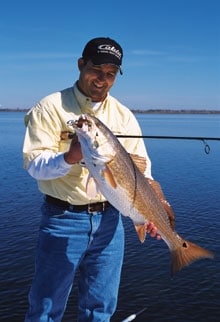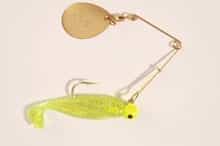
|| |—| || |Redfish can’t resist the flash and vibration of spinnerbaits. Photo: Pete Cooper, Jr.| Back in 1968 a spinnerbait accounted for the first redfish I ever hooked in Louisiana waters. Several thousand reds later -and after a few minor improvements -I still look to lures made with largemouth bass fishing in mind as my go-to choices for inshore redfish.
Best used in relatively clear and shallow water, spinnerbaits flash and vibrate to produce greater fish-attracting power than spoons and straight-up jigs. In addition, spinners are resistant to fouling on shells and vegetation. When vegetation is thick, I switch to a buzzbait and work it near the surface or grass edges.
Spin and Win
Effective when either slowly pumped along the bottom or buzzed alongside a bed of matted widgeongrass, spinnerbaits straight from the package will assuredly take reds, but I prefer to alter them slightly to improve performance. Those made with rigid wire bend with virtually every strike, so it’s best to buy -or to fashion -a more flexible version. To rig one up on your own, attach a size 31/2 or 4 gold Hildebrandt safety-pin spinner to the eye of a 1/4-ounce jighead built around a short-shank 2/0 hook. Crimp the clip on the frame of the safety pin with pliers to prevent it from being opened by a fish and thereby losing both the fish and the lure.
While the rubber or nylon skirt that typically adorns a store-bought spinnerbait has plenty of fish appeal, a better option is a soft-plastic minnow or grub 21/2 to three inches long. This is threaded over the hook and pushed securely onto the keeper at the rear of the jighead. Add a drop of super glue to the keeper to secure the soft-plastic in place.
A cast-it, let-it-sink, reel-it-in retrieve will certainly catch fish, but there are more effective techniques. Unless submerged grass poses a potential problem, first allow the lure to sink until just off the bottom. Then point the rod tip at the spinnerbait and make a long pump just fast enough so that you can feel the vibration of the blade.
The idea is to retrieve the lure without lifting it very far from the bottom. Once your rod has reached a position in which continuing the pump becomes awkward, drop the tip back toward the lure while reeling just fast enough to prevent slack line, then begin another pump.
Reds will continue along in the direction that the lure was tracking and often strike from directly behind. There will be a sharp thump, then all feeling of the vibrating spinner and the weight of the lure will be lost. When this occurs, reel quickly while dropping the rod tip toward the lure. Then, even if you feel no resistance, try to set the hook while reeling constantly. Sometimes two or even three attempts are required to get the job done, so don’t give up, even if you think the fish has dropped the lure.
Buzz Bombs

| |Lures with flexible wire can withstand more abuse. Photo: Carlos Alayo| While safety-pin spinnerbaits can be worked very effectively across the water surface, a buzzbait works better when submerged grass becomes a nuisance. Best when fished along grassy shorelines and the edges of submerged vegetation in depths no greater than three feet, buzzbaits were also created for largemouth bass, but that doesn’t deter the reds a bit. By making adjustments similar to those on the spinnerbait and replacing the standard buzzbait skirt with a grub, you will learn that buzzbaits produce redfish just as well. With the rod tip held at about ten o’clock, use a steady retrieve, just fast enough to keep its spinner chopping through the surface. At the strike, drop the tip and quickly reel in the slack line, then slam the hook home. Besides being productive, buzzbaits are great fun to fish.
Safety-pin spinnerbaits and buzzbaits may have been made for bass, but inshore reds find them equally irresistible.









